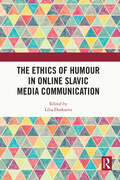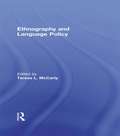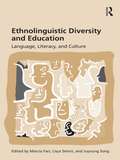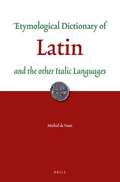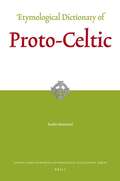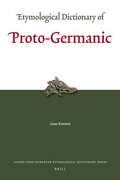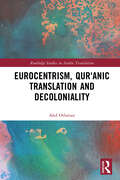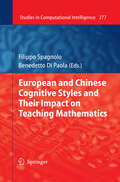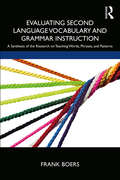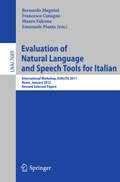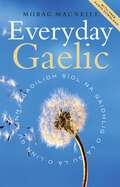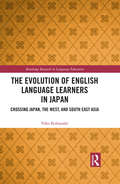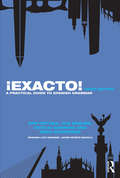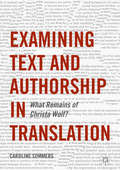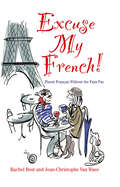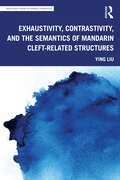- Table View
- List View
The Ethics of Humour in Online Slavic Media Communication
by Lilia DuskaevaThe Ethics of Humour in Online Slavic Media Communication is devoted to research on how the rules of humour used online media are changing and how these changes rearrange the traditions of speech interaction in media communication. The authors of the book are experienced researchers in the field of Slavic media linguistics and represent five neighbouring countries: Russia, Belarus, Lithuania, Slovakia, and Poland. The research in the volume is based on the data from Slavic languages. The diversity and, at the same time, relative proximity of Slavic languages makes it possible to put separate studies into a wider comparative context, in order to reveal the general and ethno-cultural patterns in using means of communicative etiquette; it helps define the ethno-cultural factors behind the formation of such means. Speech practice of humour creation shows the creative potential of all languages, including the ones with a small number of speakers – Slovak and Belarusian, which have the status of state languages, but are strongly influenced by international languages (English and Russian). This volume is a valuable resource for researchers in the field of Slavic studies.
The Ethics of Humour in Online Slavic Media Communication
by Duskaeva LiliaThe Ethics of Humour in Online Slavic Media Communication is devoted to research on how the rules of humour used online media are changing and how these changes rearrange the traditions of speech interaction in media communication. The authors of the book are experienced researchers in the field of Slavic media linguistics and represent five neighbouring countries: Russia, Belarus, Lithuania, Slovakia, and Poland. The research in the volume is based on the data from Slavic languages. The diversity and, at the same time, relative proximity of Slavic languages makes it possible to put separate studies into a wider comparative context, in order to reveal the general and ethno-cultural patterns in using means of communicative etiquette; it helps define the ethno-cultural factors behind the formation of such means. Speech practice of humour creation shows the creative potential of all languages, including the ones with a small number of speakers – Slovak and Belarusian, which have the status of state languages, but are strongly influenced by international languages (English and Russian). This volume is a valuable resource for researchers in the field of Slavic studies.
Ethnography and Language Policy
by Teresa L. McCartyIlluminating, through ethnographic inquiry, how individual agents "make" language policy in everyday social practice, this volume advances the growing field of language planning and policy using a critical sociocultural approach. From this perspective, language policy is conceptualized not only as official acts and documents, but as language-regulating modes of human interaction, negotiation, and production mediated by relations of power. Using this conceptual framework, the volume addresses the impacts of globalization, diaspora, and transmigration on language practices and policies; language endangerment, revitalization, and maintenance; medium-of-instruction policies; literacy and biliteracy; language and ethnic/national identity; and the ethical tensions in conducting critical ethnographic language policy research. These issues are contextualized in case studies and reflective commentaries by leading scholars in the field. Ethnography and Language Policy extends previous work in the field, tapping into leading-edge interdisciplinary scholarship, and charting new directions. Recognizing that language policy is not merely or even primarily about language per se, but rather about power relations that structure social-linguistic hierarchies, the authors seek to expand policy discourses in ways that foster social justice for all.
Ethnography and Language Policy
by Teresa L. McCartyIlluminating, through ethnographic inquiry, how individual agents "make" language policy in everyday social practice, this volume advances the growing field of language planning and policy using a critical sociocultural approach. From this perspective, language policy is conceptualized not only as official acts and documents, but as language-regulating modes of human interaction, negotiation, and production mediated by relations of power. Using this conceptual framework, the volume addresses the impacts of globalization, diaspora, and transmigration on language practices and policies; language endangerment, revitalization, and maintenance; medium-of-instruction policies; literacy and biliteracy; language and ethnic/national identity; and the ethical tensions in conducting critical ethnographic language policy research. These issues are contextualized in case studies and reflective commentaries by leading scholars in the field. Ethnography and Language Policy extends previous work in the field, tapping into leading-edge interdisciplinary scholarship, and charting new directions. Recognizing that language policy is not merely or even primarily about language per se, but rather about power relations that structure social-linguistic hierarchies, the authors seek to expand policy discourses in ways that foster social justice for all.
Ethnolinguistic Diversity and Education: Language, Literacy and Culture
by Marcia Farr Lisya Seloni Juyoung SongIn recent decades, the linguistic and cultural diversity of school populations in the United States and other industrialized countries has rapidly increased along with globalization processes. At the same time, schooling as it is currently constituted continues to be ineffective for large numbers of students. Exploring crucial issues that emerge at the intersection of linguistic diversity and education, this volume: provides an up-to-date review of sociolinguistic research and practice aimed at improving education for students who speak vernacular varieties of US English, English-based Creole languages, and non-English languages explores the impact of dialect differences and community languages on ethnolinguistically diverse students’ academic achievement challenges the dominant monolingual Standard language ideology presents sociolinguistically based approaches to language and literacy education that acknowledge and build on the linguistic and cultural resources students bring into the school. Throughout, the authors argue for the application of research-based knowledge to the dire situation (as measured by school failure and drop-out rates) of many ethnolinguistic populations in US schools. The overall aim of the volume is to heighten acknowledgement and recognition of the linguistic and cultural resources students bring into the schools and to explore ways in which these resources can be used to extend the sociolinguistic repertoires, including academic English, of all students.
Ethnolinguistic Diversity and Education: Language, Literacy and Culture
by Marcia Farr Lisya Seloni Juyoung SongIn recent decades, the linguistic and cultural diversity of school populations in the United States and other industrialized countries has rapidly increased along with globalization processes. At the same time, schooling as it is currently constituted continues to be ineffective for large numbers of students. Exploring crucial issues that emerge at the intersection of linguistic diversity and education, this volume: provides an up-to-date review of sociolinguistic research and practice aimed at improving education for students who speak vernacular varieties of US English, English-based Creole languages, and non-English languages explores the impact of dialect differences and community languages on ethnolinguistically diverse students’ academic achievement challenges the dominant monolingual Standard language ideology presents sociolinguistically based approaches to language and literacy education that acknowledge and build on the linguistic and cultural resources students bring into the school. Throughout, the authors argue for the application of research-based knowledge to the dire situation (as measured by school failure and drop-out rates) of many ethnolinguistic populations in US schools. The overall aim of the volume is to heighten acknowledgement and recognition of the linguistic and cultural resources students bring into the schools and to explore ways in which these resources can be used to extend the sociolinguistic repertoires, including academic English, of all students.
Etymological Dictionary Of Proto-celtic (Leiden Indo-european Etymological Dictionary Ser.)
by Ranko MatasovicEtymological Dictionary Of Proto-germanic (Leiden Indo-european Etymological Dictionary Ser. #11)
by Guus KroonenEurocentrism, Qurʾanic Translation and Decoloniality (Routledge Studies in Arabic Translation)
by Ahd OthmanEurocentrism, Qurʾanic Translation and Decoloniality contributes to the understanding of Eurocentrism in Translation Studies and engages with the concept through the lens of scholarship on Arabic and Qurʾan translation.This book calls for a deeper consideration of Eurocentrism as essential for several debates in the discipline, including its scientific character and future development. It claims that the angle of Arabic and Qurʾan translation is a valuable – and nearly unexploited – area where tensions in translation scholarship can play out in revealing ways. The book also draws connections between Eurocentrism, Qurʾan translation and decolonial thought in order to highlight ‘decoloniality’ as a useful framework for imagining a post-Eurocentric discipline.The book will appeal to scholars and postgraduate students and researchers interested in Translation Studies, particularly within the areas of Arabic, Qurʾanic, Islamic and religious translation.
Eurocentrism, Qurʾanic Translation and Decoloniality (Routledge Studies in Arabic Translation)
by Ahd OthmanEurocentrism, Qurʾanic Translation and Decoloniality contributes to the understanding of Eurocentrism in Translation Studies and engages with the concept through the lens of scholarship on Arabic and Qurʾan translation.This book calls for a deeper consideration of Eurocentrism as essential for several debates in the discipline, including its scientific character and future development. It claims that the angle of Arabic and Qurʾan translation is a valuable – and nearly unexploited – area where tensions in translation scholarship can play out in revealing ways. The book also draws connections between Eurocentrism, Qurʾan translation and decolonial thought in order to highlight ‘decoloniality’ as a useful framework for imagining a post-Eurocentric discipline.The book will appeal to scholars and postgraduate students and researchers interested in Translation Studies, particularly within the areas of Arabic, Qurʾanic, Islamic and religious translation.
European and Chinese Cognitive Styles and their Impact on Teaching Mathematics (Studies in Computational Intelligence #277)
by Filippo Spagnolo Benedetto Di PaolaThe book provides strong evidence that research on the cognitive processes from arithmetic thought to algebraic thought should take into consideration the socio-cultural context. It is an important contribution to the literature on linguistic structure in comparative studies related to Chinese student mathematics learning. This book not only makes a great contribution to research in mathematics education, the findings of this study also addressed insightful approaches and thoughts of understanding the development of algebraic thinking in cultural contexts for classroom teachers. Using written Chinese language from different theoretical references provided wonderful approaches for understanding student algebra cognitive development in a different way and calls educators for to pay special attention to an epistemological and linguistic view of algebraic development. The findings inform classroom teachers that the cultural context plays an important role in student learning mathematics. A typical analysis of the cognitive dimension involved in some in the historical and cultural contexts is a great resource for classroom teachers. I really enjoyed reading this book and learned a lot from its compelling analysis. Shuhua An, Associate Professor and Director of Graduate Program in Mathematics Education, California State University, Long Beach
Evaluating Second Language Vocabulary and Grammar Instruction: A Synthesis of the Research on Teaching Words, Phrases, and Patterns
by Frank BoersProviding a much-needed critical synthesis of research on teaching vocabulary and grammar to students of a second or foreign language, this book puts the research into perspective in order to distil recommendations for language teaching. Boers evaluates a comprehensive range of both well-established and lesser-known research strands and classroom practices to draw out the most effective instructional approaches to teaching words, multiword expressions and grammar patterns. Chapters discuss learning as a by-product of communicative activities, language-focused instruction, diverse types of exercises, mnemonic techniques and more, with a view to building bridges between the available research on such instructional approaches and how they are commonly implemented in actual language courses and textbooks. This book helps teachers make research-informed decisions regarding their instructional approaches to words, phrases and patterns, and direct researchers to specific areas in need of further inquiry. Boers not only demonstrates how research findings can inform effective teaching, but also calls for a deeper appreciation on the part of researchers of the realities of the teaching profession, making this a worthwhile text for preservice teachers, teacher educators, graduate students and scholars.
Evaluating Second Language Vocabulary and Grammar Instruction: A Synthesis of the Research on Teaching Words, Phrases, and Patterns
by Frank BoersProviding a much-needed critical synthesis of research on teaching vocabulary and grammar to students of a second or foreign language, this book puts the research into perspective in order to distil recommendations for language teaching. Boers evaluates a comprehensive range of both well-established and lesser-known research strands and classroom practices to draw out the most effective instructional approaches to teaching words, multiword expressions and grammar patterns. Chapters discuss learning as a by-product of communicative activities, language-focused instruction, diverse types of exercises, mnemonic techniques and more, with a view to building bridges between the available research on such instructional approaches and how they are commonly implemented in actual language courses and textbooks. This book helps teachers make research-informed decisions regarding their instructional approaches to words, phrases and patterns, and direct researchers to specific areas in need of further inquiry. Boers not only demonstrates how research findings can inform effective teaching, but also calls for a deeper appreciation on the part of researchers of the realities of the teaching profession, making this a worthwhile text for preservice teachers, teacher educators, graduate students and scholars.
Evaluation of Natural Language and Speech Tool for Italian: International Workshop, EVALITA 2011, Rome, January 24-25, 2012, Revised Selected Papers (Lecture Notes in Computer Science #7689)
by Bernardo Magnini Francesco Cutugno Mauro Falcone Emanuele PiantaEVALITA (http://www.evalita.it/) is the reference evaluation campaign of both Natural Language Processing and Speech Technologies for the Italian language. The objective of the shared tasks proposed at EVALITA is to promote the development of language technologies for Italian, providing a common framework where different systems and approaches can be evaluated and compared in a consistent manner. This volume collects the final and extended contributions presented at EVALITA 2011, the third edition of the evaluation campaign. The 36 revised full papers were carefully reviewed and selected from a total of 87 submissions. The papers are organized in topical sections roughly corresponding to evaluation tasks: parsing - dependency parsing track, parsing - constituency parsing track, domain adaptation for dependency parsing, named entity recognition on transcribed broadcast news, cross-document coreference resolution of named person entities, anaphora resolution, supersense tagging, frame labeling over italian texts, lemmatisation, automatic speech recognition - large vocabulary transcription, forced alignment on spontaneous speech.
The Evolution of English Language Learners in Japan: Crossing Japan, the West, and South East Asia (Routledge Research in Language Education)
by Yoko KobayashiThis book seeks a better understanding of the sociocultural and ideological factors that influence English study in Japan and study-abroad contexts such as university-bound high schools, female-dominant English classes at college, ESL schools in Canada, and private or university-affiliated ESL programs in Singapore and Malaysia. The discussion is based not only on data garnered from Japanese EFL learners and Japanese/overseas educators but also on official English language policies and commercial magazine discourses about English study for Japanese people. The book addresses seemingly incompatible themes that are either entrenched in or beyond Japan’s EFL context such as: Japan’s decades-long poorly-performing English education vs. its equally long-lived status as an economic power; Japanese English learners’ preference for native English speakers/norms in at-home Japanese EFL contexts vs. their friendship with other Asian students in western study-abroad contexts; Japanese female students’ dream of using English to further their careers vs. Japanese working women’s English study for self-enrichment; Japanese society’s obsession with globalization through English study vs. the Japanese economy sustained by monolingual Japanese businessmen; Japanese business magazines’ frequent cover issues on global business English study vs. Japanese working women’s magazines’ less frequent and markedly feminized discourses about English study.
The Evolution of English Language Learners in Japan: Crossing Japan, the West, and South East Asia (Routledge Research in Language Education)
by Yoko KobayashiThis book seeks a better understanding of the sociocultural and ideological factors that influence English study in Japan and study-abroad contexts such as university-bound high schools, female-dominant English classes at college, ESL schools in Canada, and private or university-affiliated ESL programs in Singapore and Malaysia. The discussion is based not only on data garnered from Japanese EFL learners and Japanese/overseas educators but also on official English language policies and commercial magazine discourses about English study for Japanese people. The book addresses seemingly incompatible themes that are either entrenched in or beyond Japan’s EFL context such as: Japan’s decades-long poorly-performing English education vs. its equally long-lived status as an economic power; Japanese English learners’ preference for native English speakers/norms in at-home Japanese EFL contexts vs. their friendship with other Asian students in western study-abroad contexts; Japanese female students’ dream of using English to further their careers vs. Japanese working women’s English study for self-enrichment; Japanese society’s obsession with globalization through English study vs. the Japanese economy sustained by monolingual Japanese businessmen; Japanese business magazines’ frequent cover issues on global business English study vs. Japanese working women’s magazines’ less frequent and markedly feminized discourses about English study.
¡Exacto!: A Practical Guide to Spanish Grammar (Routledge Concise Grammars)
by Ane Ortega Tita Beaven Cecilia Garrido Sean Scrivener¡Exacto! is an accessible guide to Spanish grammar. Using an appealing visual layout, the essentials of Spanish grammar are presented in tables and charts allowing learners to navigate the information easily and view explanations, examples of usage and any exceptions to the rule at a glance. Key features: Grids and tables ensure key information is available for quick reference and review Graded to allow students to hone in on the material most suited to their current level Coverage of Spanish as a world language, with examples from different varieties of Peninsular Spanish and Latin American Spanish Grammar and workbook in one, with exercises within each unit to practise and consolidate learning A glossary of grammatical terminology ensures all explanations within the book are clear and accessible An answer key making it ideal for self-study. Suitable for class use and independent study, this new edition of ¡Exacto! is the ideal grammar reference and practice resource for all learners of Spanish, from beginners to advanced students.
¡Exacto!: A Practical Guide to Spanish Grammar (Routledge Concise Grammars)
by Ane Ortega Tita Beaven Cecilia Garrido Sean Scrivener¡Exacto! is an accessible guide to Spanish grammar. Using an appealing visual layout, the essentials of Spanish grammar are presented in tables and charts allowing learners to navigate the information easily and view explanations, examples of usage and any exceptions to the rule at a glance. Key features: Grids and tables ensure key information is available for quick reference and review Graded to allow students to hone in on the material most suited to their current level Coverage of Spanish as a world language, with examples from different varieties of Peninsular Spanish and Latin American Spanish Grammar and workbook in one, with exercises within each unit to practise and consolidate learning A glossary of grammatical terminology ensures all explanations within the book are clear and accessible An answer key making it ideal for self-study. Suitable for class use and independent study, this new edition of ¡Exacto! is the ideal grammar reference and practice resource for all learners of Spanish, from beginners to advanced students.
Examining Text and Authorship in Translation: What Remains of Christa Wolf?
by Caroline SummersThis book, the first in-depth study of authorship in translation, explores how authorial identity is ‘translated’ in the literary text. In a detailed exploration of the writing of East German author Christa Wolf in English translation, it examines how the work of translators, publishers, readers and reviewers reframes the writer’s identity for a new reading public. This detailed study of Wolf, an author with a complex and contested public profile, intervenes in wide-ranging contemporary debates on globalised literary culture by examining how the fragmented identity of the ‘international’ author is contested by different stakeholders in the construction of a world literature. The book is interdisciplinary in its approach, representing new work in Translation Studies and German Studies that is also of interest and relevance to scholars of literature in other languages.
Examining Text and Authorship in Translation: What Remains of Christa Wolf?
by Caroline SummersThis book, the first in-depth study of authorship in translation, explores how authorial identity is ‘translated’ in the literary text. In a detailed exploration of the writing of East German author Christa Wolf in English translation, it examines how the work of translators, publishers, readers and reviewers reframes the writer’s identity for a new reading public. This detailed study of Wolf, an author with a complex and contested public profile, intervenes in wide-ranging contemporary debates on globalised literary culture by examining how the fragmented identity of the ‘international’ author is contested by different stakeholders in the construction of a world literature. The book is interdisciplinary in its approach, representing new work in Translation Studies and German Studies that is also of interest and relevance to scholars of literature in other languages.
Excuse My French: Fluent Français without the faux pas
by Rachel Best Jean-Christophe Van WaesLife together in a bi-lingual relationship for Rachel and Jean-Christophe created many amusing miscomprehensions and often sheer bewilderment. How do you translate, 'Don't beat around the bush' and why does 'to be left high and dry' in English, become 'rester en carafe' in French? Excuse My French! is their solution to all this conversational confusion. The book comprises of 700 expressions in English and in French, divided into 12 chapters, which cover all the essential topics in life - including food and drink, money, business work and sex. It presents the essential idioms and metaphors of the 'other' language in a fresh, light-hearted way that won't make you feel like you're back in a classroom. Packed with quizzes, glossaries and interesting detail on the historical contexts for how phrases were coined, and illustrated throughout with line drawings, it will improve language skills and promote the Entente Cordiale between tourists, students and business associates, as well as encourage relationships to blossom between les Gaulois et les Rosbifs all over the world!
Exhaustivity, Contrastivity, and the Semantics of Mandarin Cleft-related Structures (Routledge Studies in Chinese Linguistics)
by Ying LiuExhaustivity, Contrastivity, and the Semantics of Mandarin Cleft-related Structures investigates the semantics of the cleft and cleft-related structures in Mandarin, which, over several decades, have presented analytical challenges for semantic theory. The goal of this book, in broad terms, is three-fold: (i) to figure out what clefting adds to the semantics of a sentence; (ii) to set apart the meaning and the discourse function of each type of cleft-related structure; and (iii) to provide a uniform analysis of Mandarin clefts and their related structures. More specifically, it addresses the following questions: (i) what is the semantics of Mandarin clefts? (ii) what do exhaustivity and contrastivity contribute to the meaning of clefts? (iii) what are the semantic (or pragmatic) factors that determine the variation of clefts, related structures, and canonical sentences? and (iv) cross-linguistically speaking, how do Mandarin shi...de cleft and its related structures differ from similar constructions such as English it-cleft, French c’est cleft, and German es-cleft? This book will be informative for linguists who are working on cleft constructions and focus on sensitive structures cross-linguistically, and those interested in experimental semantics and pragmatics.
Exhaustivity, Contrastivity, and the Semantics of Mandarin Cleft-related Structures (Routledge Studies in Chinese Linguistics)
by Ying LiuExhaustivity, Contrastivity, and the Semantics of Mandarin Cleft-related Structures investigates the semantics of the cleft and cleft-related structures in Mandarin, which, over several decades, have presented analytical challenges for semantic theory. The goal of this book, in broad terms, is three-fold: (i) to figure out what clefting adds to the semantics of a sentence; (ii) to set apart the meaning and the discourse function of each type of cleft-related structure; and (iii) to provide a uniform analysis of Mandarin clefts and their related structures. More specifically, it addresses the following questions: (i) what is the semantics of Mandarin clefts? (ii) what do exhaustivity and contrastivity contribute to the meaning of clefts? (iii) what are the semantic (or pragmatic) factors that determine the variation of clefts, related structures, and canonical sentences? and (iv) cross-linguistically speaking, how do Mandarin shi...de cleft and its related structures differ from similar constructions such as English it-cleft, French c’est cleft, and German es-cleft? This book will be informative for linguists who are working on cleft constructions and focus on sensitive structures cross-linguistically, and those interested in experimental semantics and pragmatics.
